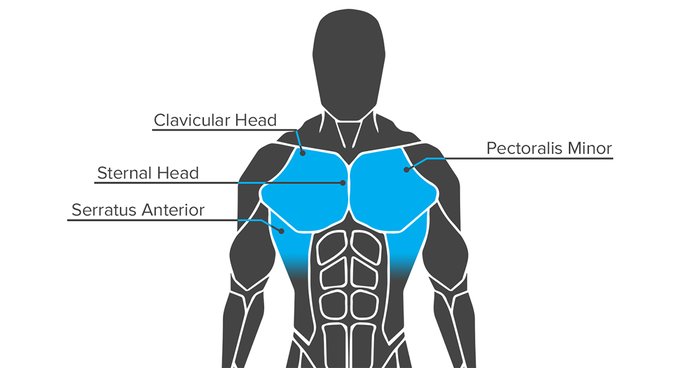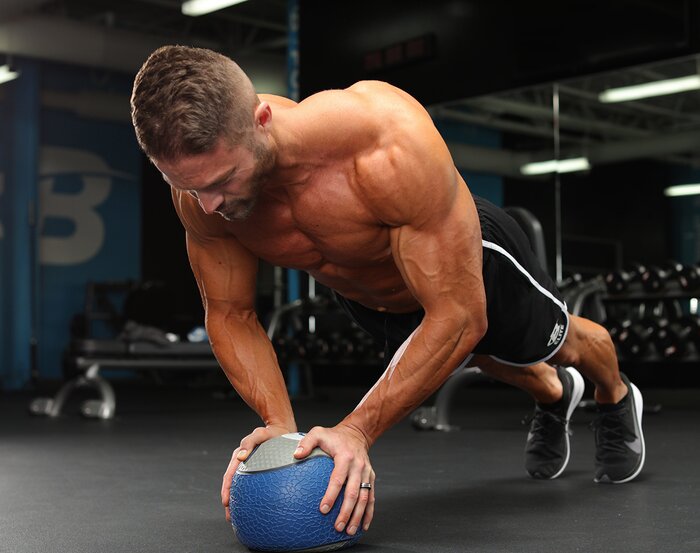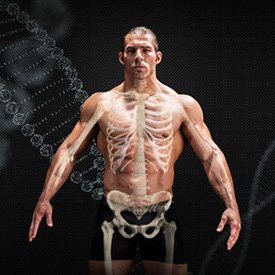Muscle Growth | Arms | Legs | Back | Chest | Shoulders | Core
A lot of guys go to the gym to build a big, thick chest, and the story pretty much begins and ends with bench press variations. Twenty, 30, or 40 sets of bench press in one workout—it's all fair game, until that fateful day when your shoulders throw up the white flag.
If any of that sounds familiar, you need a more comprehensive and science-backed approach. Here's how to train your chest more effectively based on its anatomy, targeting specific parts of the chest muscles to get the most from your hard work in the gym.
Muscular Anatomy of the Chest
Pectoralis Major
Your pectoralis major—your biggest chest muscle—has three sub-heads: the clavicular head, the sternal head, and the abdominal head. These heads are important to know because they can be specifically trained through particular movements.
Clavicular Head: The upper part of your pec major, the clavicular head runs from your clavicle (collarbone) across the top of your chest and attaches to your humerus, or upper arm. Most people struggle to build the top portion of their chest, so we'll pay special attention to this area.
Sternal Head: The sternal head is quite a bit larger than the clavicular head and runs from your sternum across your chest to insert at your humerus.
Abdominal Head: The abdominal head runs from your rectus sheath up and across the bottom portion of your chest and attaches to your humerus.

Pectoralis Minor
Your pec minor lies beneath the pec major. It's a small muscle group that you're probably not going to spend too much time trying to develop.
The pec minor runs from a little boney prominence at the top of your scapula (called the coracoid process) and attaches to ribs three, four, and five. It's mostly there to help you breathe.
Build size and strength with the right amount of protein, carbohydrates, and fat to help you add lean mass.
Serratus Anterior
You may not consider the serratus anterior a chest muscle, but you should! The serratus anterior starts from the inside of your shoulder blade, wraps around your side, and attaches onto the front of your ribcage. Really lean bodybuilders have defined serratus muscles.
Also known as the "punching muscle," your serratus anterior is most noticeable when you do something that spreads your shoulder blades. It's important for breathing, but also for building and maintaining shoulder health.
Muscular Function
Here's how your muscles and bones work together in real-world, functional movements that you do every day.
Pectoralis Major
If you put your arm out to the side and rotate it down and forward, you're rotating your arm internally. Your arm can't do that without the help of all three muscles of the pec major.
Most of us aren't too worried about arm rotation, though. We want to see striations in our chest and learn how to get big and lean. One of the best exercises to do this is the incline fly. This movement is called horizontal adduction—pulling the arm in toward the midline of the body. All the heads must work together to perform this movement.
Clavicular Head
Your clavicular head is responsible for shoulder flexion, or raising your arm over your head. Incline presses are going to hit that top portion of your chest.
Sternal and Abdominal Heads
Your torso position and the position of your shoulders make a huge difference in which portion of your chest you train. To hit the bottom portion of your chest, decline presses and dumbbell pull-overs work best.

Serratus Anterior
Your serratus anterior is most noticeable when you do something that protracts your shoulder, like when you reach forward while doing a row. The top part of a push-up also works the serratus anterior.
The serratus is also one of three muscles which allow your shoulder blade to rotate upward so you can put your arms over your head. Your serratus, lower traps, and upper traps work together to create upward rotation. Visible serratus muscles look cool, but their function is critically important to your shoulder health.
Your muscles need more than time to recover from heavy lifts. Feed your muscles exactly what they need to recover and grow.
Key Exercises for Chest Development
These movements are some of the best options for developing a strong, powerful chest.
1. Incline Dumbbell Bench Press
A big barbell bench has its place, but the dumbbell version is the popular choice among countless experienced muscle-seeking gym rats. But it's all in how you do it. As you move the dumbbells overhead, tuck your elbows down and in. Flared elbows put a lot of stress and torque on your shoulders. If this movement bothers your shoulders, move to a neutral grip with your palms facing each other.
Although you use all three heads of your pec major for this movement, pressing slightly overhead will help fill out the top part of your chest by specifically targeting the clavicular head.
2. Dumbbell Fly
Dumbbell flyes isolate the pecs and get that great horizontal adduction. This movement hits all three of your pec major heads evenly.
Begin with a stable base, engaging your abs, back, and legs. Keep your elbows soft and stretch through your pecs. As you bring your hands together, these fibers will pull together and shorten.
3. Push-Up
This total-body lift connects your upper and lower body. If you've been doing push-ups for years and haven't noticed any improvement, here are a few tips to make your push-ups more effective.
Keep your abs tight, tuck your elbows on the way down and then, to hit the serratus, exaggerate the push at the top, protracting your shoulders to lift your body as far away from the floor as possible. This extra squeeze will engage the serratus at the top of the push-up.
Mix up your movements, adding incline and decline presses to your regular flat bench program, and swapping barbells for dumbbells to influence how your muscles work. Understanding of how the bones, joints, and muscles work together will help you develop unbelievable pecs.

Learn how to train every muscle group and discover how to build your body the way you want.


